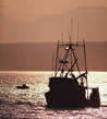
Northwest Dungeness Crab Fishery Now the Deadliest
The Discovery Channel may have to change the name of its hit show "Deadliest Catch" in light of today's MMWR report examining fatalities in the commercial fishing industry. Although Alaska's Bering Sea crab fishery has been described (on and off the Discovery Channel) as the most dangerous fishery, that dubious distinction now goes to the Northwest Dungeness crab fleet operating off the coasts of Oregon and Washington, according to the CDC study of fisheries in the region from 2000-2006.
Every year, the commercial fishing industry as a whole is one of the deadliest occupations in the country. During the seven-year study period, the industry had an average annual fatality rate of 115 deaths per 100,000 fishermen. By contrast, the average annual occupational fatality rate among all U.S. workers during the same period was four deaths per 100,000 workers. But even in an industry known for danger, the fatality rates compiled from fishing off the northwest Pacific Coast and in Alaska tend to skew the averages.
During the study period, the number of fatalities in the Bering Sea crab fishery was 11, and the fatality rate was 305 deaths per 100,000 full-time-equivalent (FTE) fishermen. By comparison, the number of deaths in the Northwest Dungeness crab fishery during 2000-2006 was 17, with a fatality rate of 463 deaths per 100,000 FTE fishermen. The Bering Sea rate represents a 60 percent reduction from the rate of 768 deaths per 100,000 FTE fishermen recorded during 1990-1999, the report notes. CDC attributes this reduction to various safety measures implemented in Alaska during the 1990s, including a preseason dockside enforcement program developed by the U.S. Coast Guard and enforcement of the Commercial Fishing Industry Vessel Safety Act, passed by Congress in 1988. The act requires boats to carry life rafts, survival suits, fire extinguishers, alerting and locating equipment, and other gear designed to improve survivability in the event of an accident.
Report author Dr. Jennifer Lincoln, who leads the NIOSH commercial fishing safety program and operates out of the agency's Alaska Pacific Regional Office, said she and other researchers compared the Northwest Dungeness crab fishery to the Bering Sea crab fishing fleet in part to assess the need for similar safety improvements in the states of California, Oregon, and Washington, which together had a total of 58 commercial fishing fatalities during the study period. Forty-three of the fatalities resulted from vessels either capsizing or sinking, 11 resulted from men falling overboard, and four resulted from other incidents involving deck or diving injuries. Lincoln said the fatalities resulting from a lack of the use of life rafts and immersion suits were "of particular concern" to the agency.
"In other NIOSH studies, we have found that the survival rate of vessel losses has increased with increased use of life rafts and immersion suits," Lincoln said. "We have also found that survivors of vessel sinkings in Alaska were approximately seven times more likely to have worn a suit than the decedents and 15 times more likely to have used a life raft." Lincoln added that to improve survival chances among Pacific Coast fishermen, who must navigate treacherous river sandbars to enter and exit ports, additional emphasis needs placing on formal marine safety training, the deployment and use of life rafts and immersion suits, and tailored safety intervention to the individual fisheries, with targeted preseason safety inspections and safety and stability training.
"Other areas of emphasis should include improved weather reporting and restrictions on crossing hazardous bars when warranted," Lincoln said. She added that NIOSH plans to continue to support the safety of the commercial fishing industry by assisting with research and evaluation of interventions, as well as the development of interventions, similar to those that have likely contributed to the significant reduction of fatalities in Alaska's commercial fishing since 1991. To access the full report, "Commercial Fishing Fatalities--California, Oregon, and Washington, 2000-2006," visit www.cdc.gov/mmwr.